Customizing Your Desktop
You can change the way your KDE desktop looks and behaves to suit your own personal tastes and needs.
Locking and Unlocking Desktop Objects
Desktop elements can be locked in their current position to prevent them from being moved around on the desktop. As long as the desktop elements are locked, you cannot add, move, or remove any objects to and from your desktop.
To lock or unlock the desktop elements, click the desktop toolbox at the upper right corner of the desktop and select or .
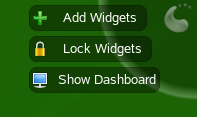
Alternatively, right-click an empty patch on the desktop and select the respective menu items from the context menu.
Changing Individual Desktop Elements
In the following, find some examples of how to change individual desktops elements.
Adding Program Icons to the Desktop or Panel
To create a link to an application and place it on the desktop or the panel, proceed as follows:
-
Click the main menu button and browse to the desired application.
-
Right-click and select or from the context menu that appears. If these menu items are not available, your desktop elements are probably locked. Unlock them first as described in Locking and Unlocking Desktop Objects.
-
To change the icon position on the desktop, left-click the icon and drag it to the desired place.
To delete an icon from your desktop, right-click the program icon and select .
Adding Widgets to the Desktop or Panel
Widgets are small applications that can be integrated into your desktop or your panel.
-
To add widgets to you desktop, right-click an empty patch on your desktop and select .
To add a widget to the panel, right-click an empty patch on the panel, and select .
If these menu items are not available, your desktop elements are probably locked. Unlock them first as described in Locking and Unlocking Desktop Objects.
-
In the dialog box that appears, you can limit the selection of widgets that is shown with the drop-down list at the top.
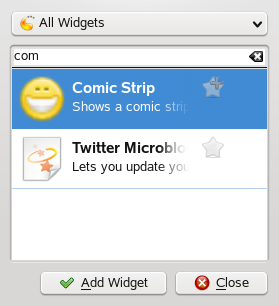
-
Select a widget and click . The widget appears on your desktop or in your panel.
-
To position the widget on your desktop, left-click the widget and drag it to it the desired place. To align all widgets to a grid, right-click an empty patch on the desktop and select or .
To remove a widget from your desktop, right-click the widget and select the entry.
Configuring Widgets
In order to configure widgets, the desktop elements need to be unlocked as described in Locking and Unlocking Desktop Objects.
-
To configure a widget, hover your mouse pointer over the widget until a translucent frame appears around the widget, showing a number of symbols.
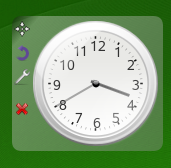
If the frame does not appear, your widgets are probably locked. Unlock them first as described in Locking and Unlocking Desktop Objects
-
To change the widget size, left-click the star symbol in the frame and keep the mouse button pressed while moving your cursor across the desktop to scale the widget size.
-
To rotate the widget in any direction, left-click the arrow symbol in the frame and keep the mouse button pressed while moving your cursor in a circle across the desktop. There is a sticky boundary in the horizontal and vertical positions where you can
clamp
the widget, if you like. Of course, you can also arrange it in any tilted position. -
To change the contents, settings, or properties of a widget, left-click the wrench symbol in the frame. In the configuration dialog box that appears, set the options according to your wishes.
Use the X symbol in the frame if you want to close the widget.
Customizing the Panel
You can customize the KDE panel according to your preferences: Applications and widgets can be added to the quick launch area or the system tray in the main panel or in additional panels. Panel elements and additional panels can be moved to different places or be completely removed at any time.
-
To move panel objects to a different place within the panel, right-click the panel object (e.g. program icon, pager, task manager, system tray) and select . Move the cursor to the desired position in the panel, right-click again and select to fix the object in the new position.
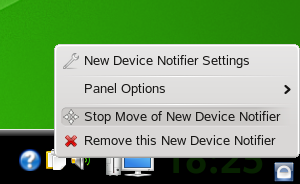
-
To remove program icons or widgets from the panel, right-click the respective object and select the menu item to remove the icon or widget.
The icons in the system tray usually belong to applications running in the background. Therefore you can only remove those icons if you close the respective application (right-click the icon and select ).
-
To change the overall appearance or behavior of the panel, select from the context menu. A configuration dialog appears where you can adjust further settings like and .
Changing the Desktop Background
You can change the background colors of your desktop or select a picture to use as the background.
-
Right-click an empty patch of the desktop and select . A configuration dialog appears.
-
From the drop-down list, choose if you want to use an , a or as background first.
-
For an image wallpaper, choose a default wallpaper from the list or download and install a . To use a custom picture, click the folder button beneath the list and select an image file from the file system. Define the of the image.
-
To have multiple images appear in a mode, define the directory from which to select the pictures and set the interval after which to change the images.
-
If you do not want a certain image or a slide show, you can set a as desktop background.
-
-
Set the other options in the configuration dialog according to your wishes and click to save your changes and leave the configuration dialog.
Modifying Personal Settings
Apart from changing individual desktop elements, KDE allows you to personalize your desktop to a very high degree. Possibilities to adjust the overall appearance and behavior of your desktop can be found in the configuration dialog.
Start the from the main menu by selecting .
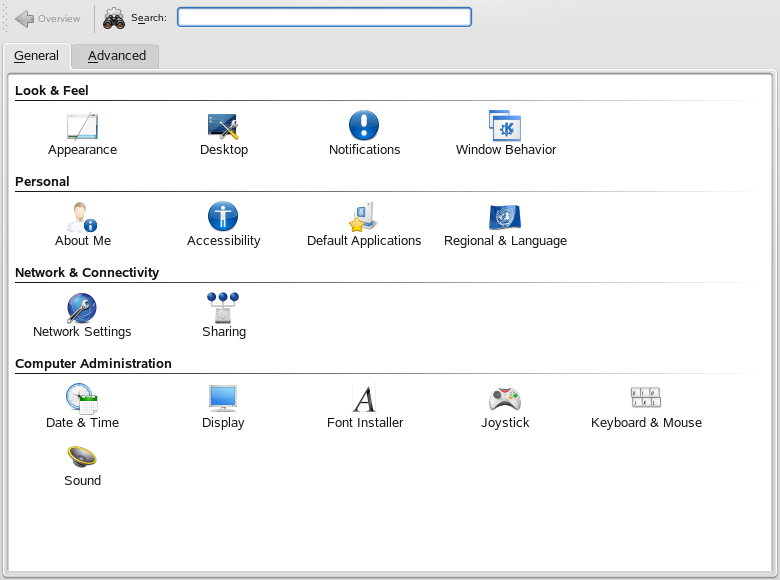
The and tabs provide different categories of settings. To get an impression of the numerous possibilities, just click a category icon and explore the possibilities provided there. Performing tasks in some areas of the control center requires system administrator (root) permissions.
Change the settings as desired. No changes take effect until you click . To discard changes in the recent view that you have not yet applied, click . To reset all items in the recent view to the default values, click .
To get back to the start-up view showing all categories again, click . You can also enter a search string at the top of the window (e.g. ) to find the category which holds options related to the search string. Each character you enter in the field narrows down the search.